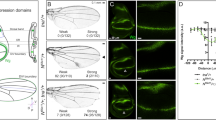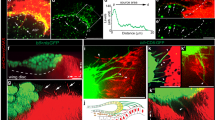Abstract
TWO secreted proteins, Wingless1,2 and Hedgehog3,4, instruct cell fates within the segmented epidermis of Drosophila embryos (reviewed in ref. 5). Wingless (Wg) is expressed by the most pos-terior cells in each parasegment; Hedgehog (Hh) is expressed in the most anterior cells of the next parasegment. Immediately after gastrulation, the two cell types are mutually dependent6,7. Local Wg signalling stabilizes Hh expression8–10 and local Hh signalling stabilizes Wg expression11,12. Direct Wg autoregulation (autocrine signalling) is masked by its paracrine role in maintaining hh, which in turn maintains wg. I have usedzeste-white3 (zM3)13 and patched(ptc)11,14 mutant backgrounds to uncouple genetically this positive-feedback loop and to study autocrine Wg signalling. I report here that direct Wg autoregulation differs from Wg signalling to adjacent cells in the importance of fused (fu), smoothened (smo) andcubitus interruptus (ci) relative to zw3 andarmadillo (arm). I also find that Wg autoregulation during this early hh-dependent phase differs from later Wg autoregulation15 by lack of gooseberry (gsb) participation.
This is a preview of subscription content, access via your institution
Access options
Subscribe to this journal
Receive 51 print issues and online access
$199.00 per year
only $3.90 per issue
Buy this article
- Purchase on Springer Link
- Instant access to full article PDF
Prices may be subject to local taxes which are calculated during checkout
Similar content being viewed by others
References
Gonzalez, F., Swales, L., Bejsovec, A., Skaer, H. & Martinez-Arias, A. Mech. Dev. 35, 43–54 (1991).
van den Heuvel, M., Nusse, R., Johnston, P. & Lawrence, P. Cell 59, 739–749 (1989).
Taylor, A. M., Nakano, Y., Mohler, J. & Ingham, P. W. Mech. Dev. 42, 89–96 (1993).
Tabata, T. & Kornberg, T. Cell 76, 89–102 (1994).
Perrimon, N. Cell 76, 781–784 (1994).
Martinez-Arias, A., Baker, N. E. & Ingham, P. W. Development 103, 157–170 (1988).
DiNardo, S., Sher, E., Heemskerk-Jorgens, J., Kassis, J. & O'Farrell, P. Nature 332, 604–609 (1988).
Mohler, J. & Vani, K. Development 115, 957–971 (1992).
Tabata, T., Eaton, S. & Kornberg, T. B. Genes Dev. 6, 2635–2645 (1992).
Lee, J. J., von Kessler, D. P., Parks, S. & Beachy, P. A. Cell 71, 33–50 (1992).
Ingham, P. W., Taylor, A. M. & Nakano, Y. Nature 353, 184–187 (1991).
Ingham, P. W. Nature 366, 560–562 (1993).
Siegfreid, E., Chou, T. & Perrimon, N. Cell 71, 1167–1179 (1992).
Bejsovec, A. & Wieschaus, E. Development 119, 501–517 (1993).
Li, X., Gutjahr, T. & Noll, M. EMBO J. 12, 1427–1436 (1993).
Siegfried, E., Perkins, L. A., Capaci, T. M. & Perrimon, N. Nature 345, 825–829 (1990).
Bejsovec, A. & Martinez-Arias, A. Development 113, 471–485 (1991).
van den Heuvel, M., Harryman-Samos, C., Klingensmith, J., Perrimon, N. & Nusse, R. EMBO J. 12, 5293–5302 (1993).
Hooper, J. E. & Scott, M. P. Cell 59, 751–765 (1989).
Nakano, Y. et al. Nature 341, 508–513 (1989).
Ingham, P. W. & Hidalgo, A. Development 117, 283–291 (1993).
Siegfreid, E., Wilder, E. L. & Perrimon, N. Nature 367, 76–80 (1994).
Noordermeer, J., Klingensmith, J., Perrimon, N. & Nusse, R. Nature 367, 80–83 (1994).
Peifer, M., Sweeton, D., Casey, M. & Wieschaus, E. Development 120, 369–380 (1994).
Peifer, M. J. Cell Sci. 105, 993–1000 (1993).
Hinck, L., Nelson, W. J. & Papkoff, J. J. Cell Biol. 124, 729–741 (1994).
Bradley, R. S., Cowin, P. & Brown, A. M. C. J. Cell Biol. 123, 1857–1865 (1993).
Forbes, A. J., Nakano, Y., Taylor, A. M. & Ingham, P. W. Development 103 (suppl.), 115–124 (1993).
Wieschaus, E. & Noell, E. Roux Arch. dev. Biol. 195, 63–73 (1986).
Kania, M. A., Bonner, A. S., Duffy, J. B. & Gergen, J. P. Genes Dev. 4, 1701–1713 (1990).
Campos-Ortega, J. A. & Hartenstein, V. The Embryonic Development of Drosophila melanogaster 1–227 (Springer, Berlin, Heidelberg, 1985).
Author information
Authors and Affiliations
Rights and permissions
About this article
Cite this article
Hooper, J. Distinct pathways for autocrine and paracrine Wingless signalling inDrosophila embryos. Nature 372, 461–464 (1994). https://doi.org/10.1038/372461a0
Received:
Accepted:
Issue Date:
DOI: https://doi.org/10.1038/372461a0
This article is cited by
-
The Hedgehog signalling pathway in bone formation
International Journal of Oral Science (2015)
-
WNTs tune up the neuromuscular junction
Nature Reviews Neuroscience (2009)
-
Cullin4B/E3-ubiquitin ligase negatively regulates β-catenin
Journal of Biosciences (2007)
-
Reading the Hedgehog morphogen gradient by measuring the ratio of bound to unbound Patched protein
Nature (2004)
-
A role for Wnt signalling in self-renewal of haematopoietic stem cells
Nature (2003)
Comments
By submitting a comment you agree to abide by our Terms and Community Guidelines. If you find something abusive or that does not comply with our terms or guidelines please flag it as inappropriate.



